New Apple TV Sales To Top One Mln Units This Week

Apple (AAPL) said it expects sales of its new Apple TV to top one million units later this week.
The new Apple TV offers the simplest way to watch your favorite HD movies and TV shows, stream content from Netflix, YouTube, Flickr and MobileMe, for just $99. iTunes users are now renting and purchasing over 400,000 TV episodes and over 150,000 movies per day.
Now with AirPlay, recently available in iOS 4.2, users can wirelessly stream their music, video and photos from iPad, iPhone and iPod touch to their new Apple TV.
Meanwhile, users can also control Apple TV with their iPad, iPhone or iPod touch using the Remote app, available as a free app on the App Store.
Apple TV is a digital media receiver made and sold by Apple Inc. It is a small form factor network appliance designed to play IPTV digital content originating from the iTunes Store, Netflix, YouTube, Flickr, MobileMe or any Mac OS X or Windows computer running iTunes onto an enhanced-definition or high-definition widescreen television.
Apple TV was unveiled as a work in progress called iTV at a press conference in San Francisco, California on September 12, 2006 and began shipping it the following March. It initially shipped with a 40GB hard disk; a 160GB version was introduced two months later and the earlier model was ultimately discontinued.
In September 2010, Apple announced a second-generation version of the Apple TV. About a quarter of the size and one-third of the price of the original Apple TV, the new device can stream rented content from iTunes and video from computers or iOS devices via AirPlay.
The new version has no hard drive; however, it does have 8 gigabytes of flash storage for caching purposes. All content is drawn from online or locally connected sources.
Apple TV allows consumers to use an HDTV set to view photos, play music and watch video that originates from limited Internet services or a local network. The first generation (white) had iTunes, Flickr, Mobileme/.Mac, and Youtube. The second generation added Netflix. Both models supported downloading/streaming podcasts.
Notable competitors include Western Digital Media Center, Roku, and Google TV.
© Copyright IBTimes 2025. All rights reserved.





















